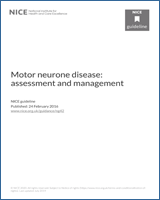All rights reserved. This material may be freely reproduced for educational and not-for-profit purposes. No reproduction by or for commercial organisations, or for commercial purposes, is allowed without the express written permission of NICE.
NCBI Bookshelf. A service of the National Library of Medicine, National Institutes of Health.
This publication is provided for historical reference only and the information may be out of date.
Excerpt
Motor neurone disease (MND) is a fatal neurodegenerative disease. It is characterised by the onset of symptoms and signs of degeneration of primarily the upper and lower motor neurones. This leads to progressive weakness of the bulbar, limb, thoracic and abdominal muscles. Respiratory muscle weakness resulting in respiratory impairment is a major feature of MND, and is a strong predictor of quality of life and survival. Non-invasive ventilation can improve symptoms and signs related to respiratory impairment and hence survival.
There is currently no evidence-based guideline for use in England, Wales and Northern Ireland that addresses the use of non-invasive ventilation in patients with MND. This guideline considers the signs and symptoms that can be used for predicting respiratory impairment in patients with MND, the diagnostic accuracy of investigations for detecting and monitoring respiratory impairment, the clinical and cost effectiveness of non-invasive ventilation for treating respiratory impairment and the information and support needs of patients and their families and carers relating to the use of non-invasive ventilation.
Contents
- Introduction
- Patient-centred care
- 1. Summary
- 2. How this guideline was developed
- 2.1. The identification and assessment of respiratory impairment in patients with motor neurone disease: clinical symptoms and signs
- 2.2. The identification and assessment of respiratory impairment in patients with motor neurone disease: respiratory function tests
- 2.3. Clinical and cost effectiveness of non-invasive ventilation for the treatment of respiratory impairment in patients with motor neurone disease
- 2.4. Key elements in the management of the use of non-invasive ventilation for patients with motor neurone disease
- 2.5. Information and support needs of patients with motor neurone disease and their families and carers
- 3. Research recommendations
- 3.1. Cost effectiveness of non-invasive ventilation for patients with MND
- 3.2. Withdrawing non-invasive ventilation at the end of life
- 3.3. Communication with patients, families and carers
- 3.4. Non-invasive ventilation for patients with MND with severe bulbar impairment
- 3.5. Training and education needs
- 4. Other versions of this guideline
- 5. Related NICE guidance
- 6. Updating the guideline
- 7. References, glossary and abbreviations
- 8. Contributors
- 9 Appendices
- Appendix 9.1. Scope
- Appendix 9.2. Key clinical issues, review questions and review protocol
- Appendix 9.3. Results of GDG short questionnaires
- Appendix 9.4. Lists of excluded studies
- Appendix 9.5. Literature search and search strategies
- Appendix 9.6. Evidence tables
- Appendix 9.7. Health economic evaluation
NICE clinical guidelines are recommendations about the treatment and care of people with specific diseases and conditions in the NHS in England and Wales.
This guidance represents the view of NICE, which was arrived at after careful consideration of the evidence available. Healthcare professionals are expected to take it fully into account when exercising their clinical judgement. However, the guidance does not override the individual responsibility of healthcare professionals to make decisions appropriate to the circumstances of the individual patient, in consultation with the patient and/or guardian or carer, and informed by the summary of product characteristics of any drugs they are considering.
Implementation of this guidance is the responsibility of local commissioners and/or providers. Commissioners and providers are reminded that it is their responsibility to implement the guidance, in their local context, in light of their duties to avoid unlawful discrimination and to have regard to promoting equality of opportunity. Nothing in this guidance should be interpreted in a way that would be inconsistent with compliance with those duties.
- Review Sleep disordered breathing in motor neurone disease.[J Thorac Dis. 2018]Review Sleep disordered breathing in motor neurone disease.D'Cruz RF, Murphy PB, Kaltsakas G. J Thorac Dis. 2018 Jan; 10(Suppl 1):S86-S93.
- Review Motor Neurone Disease: Assessment and Management[ 2016]Review Motor Neurone Disease: Assessment and ManagementNational Clinical Guideline Centre (UK). 2016 Feb
- Review Respiratory complications related to bulbar dysfunction in motor neuron disease.[Acta Neurol Scand. 2001]Review Respiratory complications related to bulbar dysfunction in motor neuron disease.Hadjikoutis S, Wiles CM. Acta Neurol Scand. 2001 Apr; 103(4):207-13.
- Review The Benefit of Non-invasive Ventilation in Motor Neuron Disease.[Open Respir Med J. 2020]Review The Benefit of Non-invasive Ventilation in Motor Neuron Disease.Walsh LJ, Murphy DM. Open Respir Med J. 2020; 14:53-61. Epub 2020 Dec 15.
- Palliative care in motor neurone disease.[Int J Palliat Nurs. 1995]Palliative care in motor neurone disease.Barby TF, Leigh PN. Int J Palliat Nurs. 1995 Oct 2; 1(4):183-188.
- Motor Neurone DiseaseMotor Neurone Disease
- LOC119104886 [Pollicipes pollicipes]LOC119104886 [Pollicipes pollicipes]Gene ID:119104886Gene
- ANK1 ankyrin 1 [Homo sapiens]ANK1 ankyrin 1 [Homo sapiens]Gene ID:286Gene
Your browsing activity is empty.
Activity recording is turned off.
See more...

